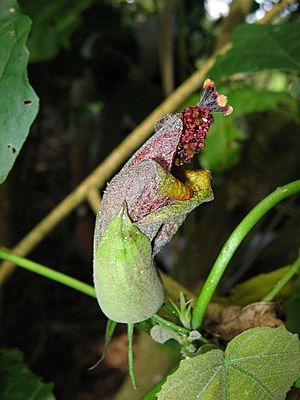Kilauea hau kuahiwi facts for kids
Quick facts for kids Kilauea hau kuahiwi |
|
|---|---|
 |
|
| Conservation status | |
| Scientific classification | |
| Genus: |
Hibiscadelphus
|
| Species: |
giffardianus
|
The Kilauea hau kuahiwi (scientific name: Hibiscadelphus giffardianus) is a very special flowering plant. It belongs to the mallow family, which includes many beautiful flowers like the hibiscus. This plant is endemic to the Big Island of Hawaii. This means it naturally grows nowhere else in the world! Sadly, scientists believe it is extinct in the wild. This means it no longer grows naturally in its original home. Any plants still alive are grown by people. These plants are in danger because their natural homes are being lost.
Contents
About the Kilauea Hau Kuahiwi
The Kilauea hau kuahiwi is a small tree. It can grow up to about 7 meters (23 feet) tall. Its trunk can be around 30 centimeters (12 inches) wide. It was first described in 1911 by a scientist named Joseph Rock.
Where It Lives
This unique plant used to live on the slopes of Mauna Loa volcano on the Big Island of Hawaii. It grew in mixed mesic forests. These are forests that get a medium amount of rain. It preferred elevations between 1,200 and 1,310 meters (about 3,900 to 4,300 feet) above sea level.
Its Forest Neighbors
The Kilauea hau kuahiwi shared its home with many other native Hawaiian plants. Some of its plant neighbors included:
- ʻōhiʻa lehua (Metrosideros polymorpha)
- koa (Acacia koa)
- mānele (Sapindus saponaria)
- hoio (Diplazium sandwicianum)
- pilo (Coprosma species)
- māmaki (Pipturus albidus)
- kōpiko (Psychotria species)
- olopua (Nestegis sandwicensis)
- alani (Melicope species)
- ʻaʻaliʻi (Dodonaea viscosa)
- naio (Myoporum sandwicense)
These plants formed a special ecosystem where the Kilauea hau kuahiwi once thrived.
Why It's Rare
The main reason the Kilauea hau kuahiwi is almost gone is habitat loss. This means its natural forest home has been destroyed or changed. This can happen because of human activities like building or farming. It can also happen due to invasive species that take over its habitat.
Conservation Efforts
Even though it's believed to be extinct in the wild, some Kilauea hau kuahiwi plants still exist. They are grown in places like Hawaii Volcanoes National Park. Scientists and conservationists are working to protect these remaining plants. They hope to one day reintroduce them into their natural habitat. This effort helps keep this unique Hawaiian plant from disappearing forever.


